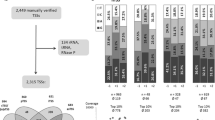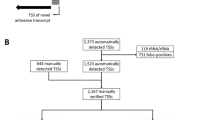Abstract
Clostridium tyrobutyricum has great potential for bio-based chemicals and biofuel production from mannitol; however, the mannitol metabolic pathway and its metabolic regulatory mechanism have not been elucidated. To this end, the RNA-seq analysis on the mid-log growth phase of C. tyrobutyricum grown on mannitol or xylose was performed. Comparative transcriptome analysis and co-transcription experiment indicated that mtlARFD, which encodes the mannitol-specific IIA component, transcription activator, mannitol-specific IIBC components, and mannitol-1-phosphate 5-dehydrogenase, respectively, formed a polycistronic operon and could be responsible for mannitol uptake and metabolism. In addition, comparative genomic analysis of the mtlARFD organization and the MtlR protein structural domain among various Firmicutes strains identified the putative cre (catabolite-responsive element) sites and conserved phosphorylation sites, but whether the expression of mannitol operon was affected by CcpA- and MtlR-mediated metabolic regulation during mixed substrate fermentation needs to be further verified experimentally. Based on the gene knockout and complementation results, the predicted mannitol operon mtlARFD was confirmed to be responsible for mannitol utilization in C. tyrobutyricum. The results of this study could be used to enhance the mannitol metabolic pathway and explore the potential metabolic regulation mechanism of mannitol during mixed substrate fermentation.




Similar content being viewed by others
Availability of Data and Materials
The data sets generated and/or analyzed during the current study are available from the corresponding author on reasonable request.
References
Martinez-Miranda, J. G., Chairez, I., & Duran-Paramo, E. (2022). Mannitol production by heterofermentative lactic acid bacteria: A review. Applied Biochemistry and Biotechnology, 194, 2762–2795.
Cesario, T. M., da Fonseca, M. M. R., Marques, M. M., & de Almeida, M. C. M. D. (2018). Marine algal carbohydrates as carbon sources for the production of biochemicals and biomaterials. Biotechnology Advances, 36, 798–817.
Wei, N., Quarterman, J., & Jin, Y. S. (2013). Marine macroalgae: An untapped resource for producing fuels and chemicals. Trends in Biotechnology, 31, 70–77.
Zheng, Y. T., Li, Y. P., Yang, Y. Y., Zhang, Y., Wang, D., Wang, P. Y., Wong, A. C. Y., Hsieh, Y. S. Y., & Wang, D. M. (2022). Recent advances in bioutilization of marine macroalgae carbohydrates: Degradation, metabolism, and fermentation. Journal of Agricultural and Food Chemistry, 70, 1438–1453.
Fu, H. X., Hu, J. L., Guo, X. L., Feng, J., Yang, S. T., & Wang, J. F. (2021). Butanol production from Saccharina japonica hydrolysate by engineered Clostridium tyrobutyricum: The effects of pretreatment method and heat shock protein overexpression. Bioresource Technology, 335, 125290.
Fu, H. X., Hu, J. L., Guo, X. L., Feng, J., Zhang, Y. N., & Wang, J. F. (2020). High-selectivity butyric acid production from Saccharina japonica hydrolysate by Clostridium tyrobutyricum. Industrial and Engineering Chemistry Research, 59, 17147–17155.
Kim, N. J., Li, H., Jung, K., Chang, H. N., & Lee, P. C. (2011). Ethanol production from marine algal hydrolysates using Escherichia coli KO11. Bioresource Technology, 102, 7466–7469.
Lee, H., & Schneider, H. (1987). Ethanol production from xylitol and some other polyols by Pichia angophorae. Biotechnology Letters, 9, 581–584.
Horn, S. J., Aasen, I. M., & Ostgaard, K. (2000). Production of ethanol from mannitol by Zymobacter palmae. Journal of Industrial Microbiology and Biotechnology, 24, 51–57.
Enquist-Newman, M., Faust, A. M. E., Bravo, D. D., Santos, C. N. S., Raisner, R. M., Hanel, A., Sarvabhowman, P., Le, C., Regitsky, D. D., Cooper, S. R., Peereboom, L., Clark, A., Martinez, Y., Goldsmith, J., Cho, M. Y., Donohoue, P. D., Luo, L., Lamberson, B., Tamrakar, P., … Yoshikuni, Y. (2014). Efficient ethanol production from brown macroalgae sugars by a synthetic yeast platform. Nature, 505, 239–243.
Peng, X., Okai, N., Vertes, A. A., Inatomi, K., Inui, M., & Yukawa, H. (2011). Characterization of the mannitol catabolic operon of Corynebacterium glutamicum. Applied Microbiology and Biotechnology, 91, 1375–1387.
Brunker, P., Hils, M., Altenbuchner, J., & Mattes, R. (1998). The mannitol utilization genes of Pseudomonas fluorescens are regulated by an activator: Cloning, nucleotide sequence and expression of the mtlR gene. Gene, 215, 19–27.
Behrens, S., Mitchell, W. J., & Bahl, H. (2001). Molecular analysis of the mannitol operon of Clostridium acetobutylicum encoding a phosphotransferase system and a putative PTS-modulated regulator. Microbiology-Sgm., 147, 75–86.
Davis, T., Yamada, M., Elgort, M., & Saier, M. H. (1988). Nucleotide sequence of the mannitol (mtl) operon in Escherichia coli. Molecular Microbiology, 2, 405–412.
Mukesh, M., Vishal, P., Andleeb, Z., Gupta, V. K., & Upadhyay, R. S. (2015). Mannitol metabolism during pathogenic fungal-host interactions under stressed conditions. Frontiers in Microbiology, 6, 1019.
Mitchell, W. J. (1998). Physiology of carbohydrate to solvent conversion by Clostridia. Advances in Microbial Physiology, 39, 31–130.
Deutscher, J., Francke, C., & Postma, P. W. (2006). How phosphotransferase system-related protein phosphorylation regulates carbohydrate metabolism in bacteria. Microbiology and Molecular Biology Reviews, 70, 939–1031.
Fu, H. X., Zhang, H. H., Guo, X. L., Yang, L., & Wang, J. F. (2022). Elimination of carbon catabolite repression in Clostridium tyrobutyricum for enhanced butyric acid production from lignocellulosic hydrolysates. Bioresource Technology, 357, 127320.
Guo, X. L., Fu, H. X., Feng, J., Hu, J. L., & Wang, J. F. (2020). Direct conversion of untreated cane molasses into butyric acid by engineered Clostridium tyrobutyricum. Bioresource Technology, 301, 122764.
Bao, T., Feng, J., Jiang, W., Fu, H., & Yang, S. T. (2020). Recent advances in n-butanol and butyrate production using engineered Clostridium tyrobutyricum. World Journal of Microbiology and Biotechnology, 36, 138.
Jiang, L., Fu, H. X., Yang, H. K., Xu, W., Wang, J. F., & Yang, S. T. (2018). Butyric acid: Applications and recent advances in its bioproduction. Biotechnology Advances, 36, 2101–2117.
Lee, J., Jang, Y. S., Han, M. J., Kim, J. Y., & Lee, S. Y. (2016). Deciphering Clostridium tyrobutyricum metabolism based on the whole-genome sequence and proteome analyses. MBio, 7(3), e00743-e816.
Xiao, H., Bang-Berthelsen, C. H., Jensen, P. R., & Solem, C. (2021). Deciphering the regulation of the mannitol operon paves the way for efficient production of mannitol in Lactococcus lactis. Applied and Environmental Microbiology, 87(16), e0077921.
Zhang, J., Hong, W., Guo, L., Wang, Y. F., & Wang, Y. (2020). Enhancing plasmid transformation efficiency and enabling CRISPR-Cas9/Cpf1-based genome editing in Clostridium tyrobutyricum. Biotechnology and Bioengineering, 117, 2911–2917.
Fu, H. X., Yang, S. T., Wang, M. Q., Wang, J. F., & Tang, I. C. (2017). Butyric acid production from lignocellulosic biomass hydrolysates by engineered Clostridium tyrobutyricum overexpressing xylose catabolism genes for glucose and xylose co-utilization. Bioresource Technology, 234, 389–396.
Fu, H. X., Yu, L., Lin, M., Wang, J. F., Xiu, Z. L., & Yang, S. T. (2017). Metabolic engineering of Clostridium tyrobutyricum for enhanced butyric acid production from glucose and xylose. Metabolic Engineering, 40, 50–58.
Suo, Y. K., Fu, H. X., Ren, M. M., Yang, X. T., Liao, Z. P., & Wang, J. F. (2018). Butyric acid production from lignocellulosic biomass hydrolysates by engineered Clostridium tyrobutyricum overexpressing class I heat shock protein GroESL. Bioresource Technology, 250, 691–698.
Gu, Y., Ding, Y., Ren, C., Sun, Z., Rodionov, D. A., Zhang, W. W., Yang, S., Yang, C., & Jiang, W. H. (2010). Reconstruction of xylose utilization pathway and regulons in Firmicutes. BMC Genomics, 11, 255.
Sun, Z., Chen, Y. X., Yang, C., Yang, S., Gu, Y., & Jiang, W. H. (2015). A novel three-component system-based regulatory model for D-xylose sensing and transport in Clostridium beijerinckii. Molecular Microbiology, 95, 576–589.
Deutscher, J., Reizer, J., Fischer, C., Galinier, A., Saier, M. H., Jr., & Steinmetz, M. (1994). Loss of protein kinase-catalyzed phosphorylation of HPr, a phosphocarrier protein of the phosphotransferase system, by mutation of the ptsH gene confers catabolite repression resistance to several catabolic genes of Bacillus subtilis. Journal of Bacteriology, 176(11), 3336–3344.
Bruder, M. R., Pyne, M. E., Moo-Young, M., Chung, D. A., & Chou, C. P. (2016). Extending CRISPR-Cas9 technology from genome editing to transcriptional engineering in the genus Clostridium. Applied and Environment Microbiology, 82(20), 6109–6119.
Ujor, V. C., Lai, L. B., Okonkwo, C. C., Gopalan, V., & Ezeji, T. C. (2021). Ribozyme-mediated downregulation uncovers DNA integrity scanning protein A (DisA) as a solventogenesis determinant in Clostridium beijerinckii. Frontiers in Bioengineering and Biotechnology, 9, 669462.
Wu, Y., Yang, Y., Ren, C., Yang, C., Yang, S., Gu, Y., & Jiang, W. (2015). Molecular modulation of pleiotropic regulator CcpA for glucose and xylose coutilization by solvent-producing Clostridium acetobutylicum. Metabolic Engineering, 28, 169–179.
Bruder, M., Moo-Young, M., Chung, D. A., & Chou, C. P. (2015). Elimination of carbon catabolite repression in Clostridium acetobutylicum-A journey toward simultaneous use of xylose and glucose. Applied Microbiology and Biotechnology, 99(18), 7579–7588.
Funding
This work was supported by National Natural Science Foundation of China (21808069 and 22178133), Guangzhou Basic and Applied Basic Research (202102020281), and Science and Technology Planning Project of Guangdong Province of China (2019A050510008).
Author information
Authors and Affiliations
Contributions
HXF and JFW conceived and designed research. LY and HHZ conducted experiments. HXF and LY analyzed data. HXF wrote the manuscript. All authors read and approved the manuscript.
Corresponding authors
Ethics declarations
Ethical Approval
Not applicable
Consent to Participate
Not applicable
Consent for Publication
Not applicable
Competing Interests
The authors declare no competing interests.
Additional information
Publisher's Note
Springer Nature remains neutral with regard to jurisdictional claims in published maps and institutional affiliations.
Supplementary Information
Below is the link to the electronic supplementary material.
Rights and permissions
Springer Nature or its licensor (e.g. a society or other partner) holds exclusive rights to this article under a publishing agreement with the author(s) or other rightsholder(s); author self-archiving of the accepted manuscript version of this article is solely governed by the terms of such publishing agreement and applicable law.
About this article
Cite this article
Fu, H., Yang, L., Zhang, H. et al. Deciphering of the Mannitol Metabolism Pathway in Clostridium tyrobutyricum ATCC 25755 by Comparative Transcriptome Analysis. Appl Biochem Biotechnol 195, 1072–1084 (2023). https://doi.org/10.1007/s12010-022-04209-8
Accepted:
Published:
Issue Date:
DOI: https://doi.org/10.1007/s12010-022-04209-8




